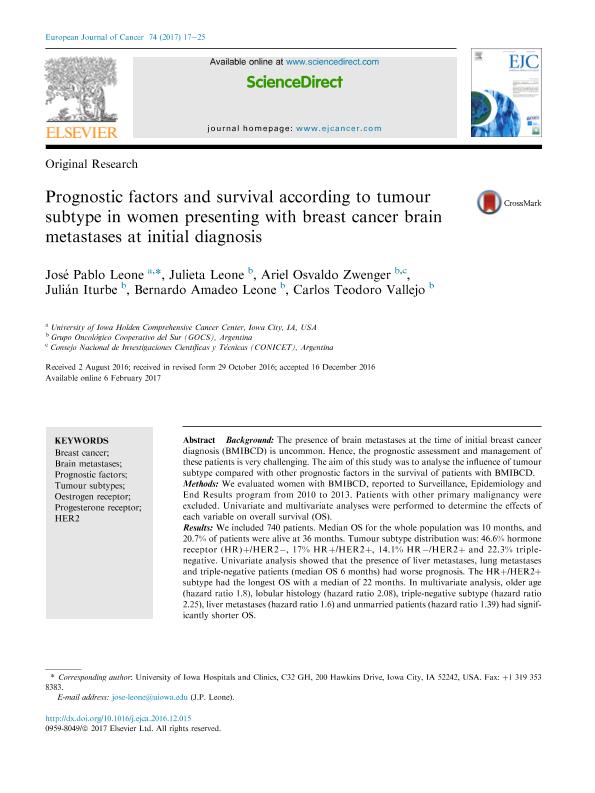Mostrar el registro sencillo del ítem
dc.contributor.author
Leone, José Pablo
dc.contributor.author
Leone, Julieta
dc.contributor.author
Zwenger, Ariel

dc.contributor.author
Iturbe, Julián
dc.contributor.author
Leone, Bernardo Amadeo
dc.contributor.author
Vallejo, Carlos Teodoro
dc.date.available
2019-05-06T20:44:24Z
dc.date.issued
2017-03
dc.identifier.citation
Leone, José Pablo; Leone, Julieta; Zwenger, Ariel; Iturbe, Julián; Leone, Bernardo Amadeo; et al.; Prognostic factors and survival according to tumour subtype in women presenting with breast cancer brain metastases at initial diagnosis; Elsevier; European Journal of Cancer; 74; 3-2017; 17-25
dc.identifier.issn
0959-8049
dc.identifier.uri
http://hdl.handle.net/11336/75694
dc.description.abstract
Background The presence of brain metastases at the time of initial breast cancer diagnosis (BMIBCD) is uncommon. Hence, the prognostic assessment and management of these patients is very challenging. The aim of this study was to analyse the influence of tumour subtype compared with other prognostic factors in the survival of patients with BMIBCD. Methods We evaluated women with BMIBCD, reported to Surveillance, Epidemiology and End Results program from 2010 to 2013. Patients with other primary malignancy were excluded. Univariate and multivariate analyses were performed to determine the effects of each variable on overall survival (OS). Results We included 740 patients. Median OS for the whole population was 10 months, and 20.7% of patients were alive at 36 months. Tumour subtype distribution was: 46.6% hormone receptor (HR)+/HER2−, 17% HR+/HER2+, 14.1% HR−/HER2+ and 22.3% triple-negative. Univariate analysis showed that the presence of liver metastases, lung metastases and triple-negative patients (median OS 6 months) had worse prognosis. The HR+/HER2+ subtype had the longest OS with a median of 22 months. In multivariate analysis, older age (hazard ratio 1.8), lobular histology (hazard ratio 2.08), triple-negative subtype (hazard ratio 2.25), liver metastases (hazard ratio 1.6) and unmarried patients (hazard ratio 1.39) had significantly shorter OS. Conclusions Although the prognosis of patients with BMIBCD is generally poor, 20.7% were still alive 3 years after the diagnosis. There were substantial differences in OS according to tumour subtype. In addition to tumour subtype, other independent predictors of OS are age at diagnosis, marital status, histology and liver metastases.
dc.format
application/pdf
dc.language.iso
eng
dc.publisher
Elsevier

dc.rights
info:eu-repo/semantics/openAccess
dc.rights.uri
https://creativecommons.org/licenses/by-nc-nd/2.5/ar/
dc.subject
Brain Metastases
dc.subject
Breast Cancer
dc.subject
Her2
dc.subject
Oestrogen Receptor
dc.subject
Progesterone Receptor
dc.subject
Prognostic Factors
dc.subject
Tumour Subtypes
dc.subject.classification
Otras Medicina Clínica

dc.subject.classification
Medicina Clínica

dc.subject.classification
CIENCIAS MÉDICAS Y DE LA SALUD

dc.title
Prognostic factors and survival according to tumour subtype in women presenting with breast cancer brain metastases at initial diagnosis
dc.type
info:eu-repo/semantics/article
dc.type
info:ar-repo/semantics/artículo
dc.type
info:eu-repo/semantics/publishedVersion
dc.date.updated
2019-04-11T20:14:38Z
dc.journal.volume
74
dc.journal.pagination
17-25
dc.journal.pais
Países Bajos

dc.journal.ciudad
Amsterdam
dc.description.fil
Fil: Leone, José Pablo. University of Iowa; Estados Unidos
dc.description.fil
Fil: Leone, Julieta. Grupo Oncológico Cooperativo del Sur; Argentina
dc.description.fil
Fil: Zwenger, Ariel. Grupo Oncológico Cooperativo del Sur; Argentina. Consejo Nacional de Investigaciones Científicas y Técnicas; Argentina
dc.description.fil
Fil: Iturbe, Julián. Grupo Oncológico Cooperativo del Sur; Argentina
dc.description.fil
Fil: Leone, Bernardo Amadeo. Grupo Oncológico Cooperativo del Sur; Argentina
dc.description.fil
Fil: Vallejo, Carlos Teodoro. Grupo Oncológico Cooperativo del Sur; Argentina
dc.journal.title
European Journal of Cancer

dc.relation.alternativeid
info:eu-repo/semantics/altIdentifier/doi/http://dx.doi.org/10.1016/j.ejca.2016.12.015
dc.relation.alternativeid
info:eu-repo/semantics/altIdentifier/url/https://www.sciencedirect.com/science/article/pii/S0959804917300199
Archivos asociados
